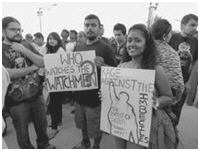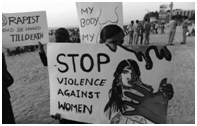By Arun D. Jatkar and Kollengode S. Venkataraman
Note: Arun Jatkar, a long-time Monroeville resident, edits Ekata, a Marathi monthly published from Toronto, Canada.
In late 2012, the gang-rape of a college-going young woman returning home from a movie in the evening with her male friend in New Delhi drew wide coverage in the Indian and global media. That she was gang-raped by six men right in front of her badly beaten-up male friend and dumped on the road severely wounded only to die later, touched a raw nerve among Indian women. After all, it could be any one of them.
Violence against women has always been an endemic problem in India. Rape, particularly gang rape, is an extreme case. Social stigma is one reason why rape cases are rarely reported to the police. Even in the US, as an NPR story reported in mid-January, rapes and attempted rapes are the least-reported crimes in Washington, D.C., the nation’s capital.
That is not the only reason. Indians have become cynical of their criminal justice system for good reason: over 4.3 million cases are pending in Indian High Courts alone (excluding subordinate courts). A judicial commission reporting on the Delhi gang rape stated the obvious: Lack of governance.
But this time, educated women in Delhi protested against the gang rape publicly. They feel they have silently suffered long enough with the molestations by, and aggressive behavior of, men in buses, trains and other public places. After all, every incident of rape occurs after several episodes of aggressive behavior by men. With their economic independence, working women came out protesting. Enough is enough.
Violence against women is a global problem. See here: http://http://tinyurl.com/Delhi-Stbnvl. Rapes have multiple causes — some are generic, others are specific to each society. The patriarchal nature of society is blamed for it in the case of India. To varying degrees, almost all societies are male-dominated and macho, if not “patriarchal.â€
The urban, educated and affluent Indians have a selective and skewed perception of “modern†India, which they project in the Indian English media, in their interactions among themselves and with their global contacts. What is galling and embarrassing to these Indians is that violence against women, like rapes, dowry deaths, and female foeticides, stands in sharp contrast to the skewed image they have created for themselves and internalized.
The protestors were asking the government to act forcefully on rapes, while shaming the government in the media.
But treating serious social crimes against women as a criminal justice issue misses the other socioeconomic and cultural underpinnings. It is worth recalling what Ela Gandhi, the granddaughter of Mohandas Gandhi and a social worker in South Africa, said during her visit to India in January 2013:
“Law[s] alone cannot solve the problems of society. The attitude of the people need to change … … The malaise in society lies in the divisions of caste, class and gender, the three evils that result in societal problems, and women were generally the first victim of all conflicts… … The divisions… … deny access to education, food, healthcare and housing for all in an equitable manner.â€
It is well-known that socioeconomic and cultural conditions such as education, wealth, religion, and social class (castes in India), have no bearing on sexual violence against women. So, reducing sexual violence against women needs a two-pronged approach that covers the whole population spectrum that should focus on
a) Changing the interpersonal dynamics among all teenage and adult men and women. This will try to change the behavior of Indians who are already adults. This is difficult. Ask any addict. But sometime fear of retribution will work among adults.
b) Inculcating good behavior patterns in all children from pre-school onwards. This is easy since you are catching them young in inculcating good behavior. But this requires sustained commitment from society and the resources.
The first one seeks to reduce the incidence of sexual violence committed against women by men. The second one attempts to inculcate behavior patterns in children to enable interpersonal relations and interactions conducive to reducing gender-related violence when they become adults.
Regardless of how effective the protests are, the women staging candlelight vigils and displaying protest placards in New Delhi and other places have made one thing clear: women want to let everyone know how livid they are about society’s tolerance for violence against them. This movement needs to thrive. We need brigades of women activists supporting the victimized women, helping them muster courage to go against the centuries-old social customs and traditions that place a higher value on male perception of pride and family honor than on the physical and psychological health and well-being of women.
To begin with, we ought to start with the recognition that women are an integral, equal, and complementing part of humanity as men are, and therefore are not less important than men. The dicta such as “Gods and Goddesses rejoice where women are revered,†have long been held as the essential teachings of Indian civilization. However no society, Indian or other Oriental or Occidental, has truly lived by those dicta. These ethical, moral, philosophical and intellectual underpinnings of civilization remain locked up in scriptures. They are no more than decorations on the trees of our collective delusion. Therefore, we need to concentrate on changing the attitudes and actions of individuals and of groups of individuals.
Let us not kid ourselves into expecting that the initiative will come from men. Men have made great strides in winning for themselves many freedoms. However, they have not ensured that women have the very same freedoms and not have to suffer the physical and/or psychological trauma from gender-based violence.
So, refusing to accept unfair and unjust treatment from society has to be a major part of the women’s resistance movement.
With women playing an equal role in all facets of life worldwide, societies need to evolve towards a) tempering of male machismo, and b) simultaneously steeling of women’s fortitude. It is a tall order given the history of mankind over several millennia. But true education is that which sensitizes everyone to each gender’s shortcomings in dealing with the other gender.
In the last sixty years, the urban, English-educated and affluent India — about 20% of the population — has become disconnected from its languages and cultural hinterland. In the wake of globalization, with the IT-based call centers providing 24-h technical support to global customers, the relatively incredibly well-paid “lucky ones†have internalized Western lifestyles. Now dating, going to bars for drinks, dancing in nightclubs and late night soirees are the accepted and expected norms within this slice of the youth population.
Such rapid changes affecting and benefitting a small segment of the population leave the rest of the youth population way behind. Inevitably, in the schools where India’s affluent and poor children are educated—and in the homes where they grow up—widely differing behavior patterns are instilled on the accepted and unaccepted behaviors between boys and girls. These kids become adults with an unbridgeable cultural and psychological gulf.
In urban India, out of necessity, affluent Indians and the working poor live close to each other. But the working poor lag by decades, if not centuries, behind the affluent ones in the mores on male-female relationships. The youngsters lagging behind, already backward and stymied by the difficult-to-cross Vindhya-like social boundaries, realize they can never catch up. They end up as onlookers on the periphery enviously and resentfully gawking at the social scene they see among the affluent youth.
This divide, caused by the benign neglect of social development of children from India’s poor families by its professional class is an important factor — there are many other compounding factors, no doubt — for the boorish behavior of virile men towards women in India for what goes by the term “eve-teasing.†See http://tinyurl.com/Story-in-TheHindu
If we fail to imprint proper attitudes and world views on young minds, it is difficult to change the behavior of adults. They are swayed by hormones and male hubris constantly nourished by the “anything-for-a-buck†brand of media circus. The less we say about the way Indian cinema and Western entertainment industry demean women, the better.
So, reducing gender-related violence in India needs a national com-mitment a) to change the interactions between all adult men and women now, and b) to educate the pre- and early-school children such that boys and girls of all backgrounds are trained the same way on how to interact with each other with civility and respect. This is a big challenge.
If India starts today to improve early education for all children, twenty years down the road, we may see improvements in the interactions between young men and women in both urban and rural India. Otherwise, India will be only jumping from one candlelight vigil to the next for rape victims. — April 2013


